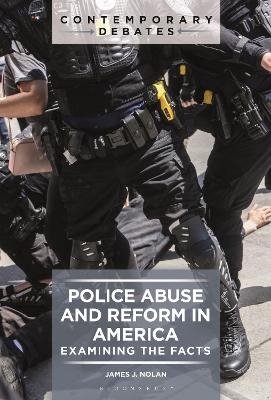
Police Abuse and Reform in America
Bloomsbury Academic (Verlag)
978-1-4408-8134-3 (ISBN)
- Noch nicht erschienen (ca. September 2025)
- Versandkostenfrei
- Auch auf Rechnung
- Artikel merken
In addition to chronicling specific notorious and controversial examples of police violence and abuse, this work delves into the root causes of police misconduct, details the varied responsibilities and culture of law enforcement in American communities, and examines the arguments for and against efforts and proposals to reform and improve police departments. In the process, Police Abuse and Reform in America gives readers a clear and unbiased understanding of the issue by carefully examining claims about the root causes and extent of police violence and abuse in the USA, as well as the efficacy of efforts to reform and improve law enforcement performance.
For example, featured essays tackle such questions as whether policing has become more dangerous over time, whether police abuse is more prevalent in communities of color, and whether reforms to address and curb incidents of police abuse are effective or counterproductive. In addition, the book examines events such as the Rodney King beating of 1992, the 2014 killing of Michael Brown in Ferguson, Missouri, and the murder of George Floyd in Minneapolis in 2020 as pivot points in American police history and the social movement landscape.
James J. Nolan is a Professor in the Department of Sociology and Anthropology at West Virginia University, USA. His research focuses on crime and neighborhood dynamics, police procedures, crime measurement, and hate crimes. A former police officer, Nolan is also a 1992 graduate of the Federal Bureau of Investigation (FBI) National Academy. He is co-editor of Policing in an Age of Reform: An Agenda for Research and Practice (2021). Howard Ryan is a doctoral student in Sociology at West Virginia University, USA. He has a background in teaching and labor organizing and is the author of Educational Justice: Teaching and Organizing against the Corporate Juggernaut. Mackenzie Freeman is a doctoral student in Sociology at West Virginia University. With a background in criminology and psychology, her research focuses on rural girls in incarceration and foster care. She is co-author of "'Suffering in Deafening Silence': Suicide Ideation and Attempted Suicide in the Lives of Incarcerated Rural West Virginia Girls."
How to Use This Book
Preface
Acknowledgments
Introduction
1. The American Police Mandate: A Game, Playbook, and Scorecard
Q1. Is there an official mandate in American policing?
Q2. Are the police effective in carrying out their mandate?
Q3. How does the police mandate contribute to the problem of abuse in policing today?
Q4. Is it possible to change the American police mandate?
2. The American Police Abuse Triad: Over-Enforcement, Excessive Force, and Discrimination
Q5. Is over-enforcement pervasive in American policing?
Q6. Is excessive force pervasive in American policing?
Q7. Is discrimination pervasive in American policing?
3. Behind American Police Abuse
Q8. Is hyper-enforcement necessary, and at what point does it become over-enforcement?
Q9. Can excessive and deadly force in American policing be explained by rising violence against officers?
Q.10. Is implicit bias the reason for discrimination in American policing?
Q.11. Are legal, policy, and ethical frameworks helpful in evaluating the use of force in American policing?
Q12. Are “bad apples” a problem in policing, and why is it so hard to eliminate them?
4. Historical Patterns in American Police Reform
Q13. How did American policing begin, and how has it evolved?
Q14. What processes are involved in the evolution of American police reform?
5. The Turbulent Sixties and Policy Debates
Q15. What caused the urban disorders—riots and rising crime—of the 1960s?
Q16. What remedies did liberal leaders advance?
Q17. What remedies did conservative leaders advance?
Q18. What historic lessons may be derived from the 1960s about policing and social policy?
6. Rodney King Beating, L.A. Riots, and Department of Justice Investigations
Q19. From the L.A. Riots of 1965 to the L.A. Riots of 1992, had things changed in American society and policing?
Q20. Have the Department of Justice investigations into local police agencies and court-ordered consent decrees aided reform?
Q21. Has the Department of Justice intervention in Baltimore been successful?
7. Ferguson Protests, Black Lives Matter, and the Obama Policing Task Force
Q22. What were the strengths and limitations of the Black Lives Matter movement in the wake of the Ferguson uprising?
Q23. What were the strengths and limitations of the Obama reforms?
Q24. Can evidence-based policing, which guided the Obama task force, produce a systemic remedy to police abuse?
8. George Floyd Murder and the Rise of Police Abolitionism
Q25. What did the Floyd murder and the Minneapolis experience tell us about police reform?
Q26. What do the police abolitionists want?
Q27. How did the abolition movement fare in Minneapolis post-Floyd?
Q28. How did the abolition movement fare in Congress post-Floyd?
9. Conventional Police Reform and Potential Alternatives
Q29. Has conventional police reform worked?
Q30. Are there alternatives for reform that could reduce police abuse and make communities safer for both residents and the police?
Index
| Erscheint lt. Verlag | 4.9.2025 |
|---|---|
| Reihe/Serie | Contemporary Debates |
| Zusatzinfo | 23 bw |
| Verlagsort | London |
| Sprache | englisch |
| Maße | 156 x 235 mm |
| Themenwelt | Recht / Steuern ► EU / Internationales Recht |
| Recht / Steuern ► Öffentliches Recht ► Verfassungsrecht | |
| Recht / Steuern ► Strafrecht ► Strafverfahrensrecht | |
| Sozialwissenschaften ► Ethnologie | |
| Sozialwissenschaften ► Soziologie | |
| ISBN-10 | 1-4408-8134-0 / 1440881340 |
| ISBN-13 | 978-1-4408-8134-3 / 9781440881343 |
| Zustand | Neuware |
| Informationen gemäß Produktsicherheitsverordnung (GPSR) | |
| Haben Sie eine Frage zum Produkt? |
aus dem Bereich


